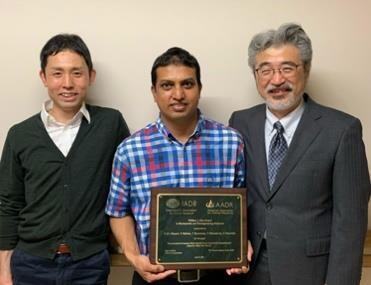Professor Shogo Takashiba of the Graduate School of Medicine Dentistry and Pharmaceutical Sciences, Okayama University, and Professor Yuta Nishina of the Research Core For Interdisciplinary Sciences formed a collaborative research group between dentistry and engineering along with graduate student Mohammad Zahedul Islam Nizami, and developed a new compound that shields the dentin of cavities and desensitized teeth. The results of this research were published in February 2020 in the "Journal of Dental Research" (JDR), the premier magazine in the dental world run by the International Association for Dental Research (IADR). On July 21, 2021, this study received the William Giles Award for "Biomaterials and Bioengineering Research" published in the previous year at the 99th IADR Academic Conference.
While the number of cavities in the primary teeth of children is decreasing, the cavities in the roots of the permanent teeth of an adult remain a challenge. Since 1970, silver fluoride diamine, a dental decay inhibitor/ hypersensitivity blunting agent, has been used to stop the progression of tooth decay. However, the color of the teeth turns black at the drug-binding site. As silver fluoride diamine is a powerful drug, caution is extremely important during its use.
Due to these circumstances, there is an unmet need for the development of a drug that is gentle and does not discolor the teeth while providing anti-bacterial effects. The research group searched for a material that could adhere to the surface of the tooth and shield the dentin tubules that lead from within the dentin to the outer surface, in a similar fashion to a lid.
It was found that graphene oxide, composed of carbon, has the property of adsorbing various substances such as activated carbon. A complex was formed by mixing bactericidal silver ions with calcium, which is also an element of teeth, and fluorine, which strengthens teeth. Complexes with other elements were also tested. However, it was found that graphene oxide and silver ion alone or as a complex with calcium fluoride exhibited the best effect. These complexes did not dissolve even under acidic conditions, exerted bactericidal effects, were gentle on human cells, and had only a slight (dentin-like) yellow color effect.
The results of this research are expected to be leveraged to the prevention of tooth decay and treatment of dental hypersensitivity in children as well as in adults. After confirming the effect in animal experiments, this agent is expected to be employed for use by humans in the future.

Credit: Okayama University
This article has been translated by JST with permission from The Science News Ltd.(https://sci-news.co.jp/). Unauthorized reproduction of the article and photographs is prohibited.




